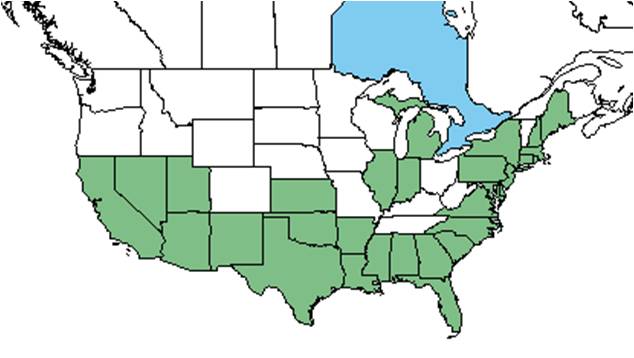Difference between revisions of "Pluchea odorata"
Krobertson (talk | contribs) (→Cultivation and restoration) |
|||
| Line 18: | Line 18: | ||
}} | }} | ||
| − | Common | + | Common names: Sweetscent, Saltmarsh fleabane |
==Taxonomic notes== | ==Taxonomic notes== | ||
Synonyms: ''Pluchea odorata'' var. ''odorata''; ''P. odorata'' (Linnaeus) Cassini var. ''succulenta'' (Fernald) Cronquist; ''P. purpurascens'' (Swartz) A.P. de Candolle var. ''purpurascens''; ''P. purpurascens'' (Swartz) A.P. de Candolle var. ''succulenta'' Fernald; ''P. purpurascens'' (Swartz) A.P. de Candolle | Synonyms: ''Pluchea odorata'' var. ''odorata''; ''P. odorata'' (Linnaeus) Cassini var. ''succulenta'' (Fernald) Cronquist; ''P. purpurascens'' (Swartz) A.P. de Candolle var. ''purpurascens''; ''P. purpurascens'' (Swartz) A.P. de Candolle var. ''succulenta'' Fernald; ''P. purpurascens'' (Swartz) A.P. de Candolle | ||
Revision as of 17:41, 14 September 2016
| Pluchea odorata | |
|---|---|
Error creating thumbnail: Unable to save thumbnail to destination
| |
| Photo taken by Gil Nelson | |
| Scientific classification | |
| Kingdom: | Plantae |
| Division: | Magnoliophyta - Flowering plants |
| Class: | Magnoliopsida – Dicotyledons |
| Order: | Asterales |
| Family: | Asteraceae |
| Genus: | Pluchea |
| Species: | P. odorata |
| Binomial name | |
| Pluchea odorata (L.) Cass. | |

| |
| Natural range of Pluchea odorata from USDA NRCS Plants Database. | |
Common names: Sweetscent, Saltmarsh fleabane
Contents
Taxonomic notes
Synonyms: Pluchea odorata var. odorata; P. odorata (Linnaeus) Cassini var. succulenta (Fernald) Cronquist; P. purpurascens (Swartz) A.P. de Candolle var. purpurascens; P. purpurascens (Swartz) A.P. de Candolle var. succulenta Fernald; P. purpurascens (Swartz) A.P. de Candolle
Description
A description of Pluchea odorata is provided in The Flora of North America.
Distribution
It is distributed from southern Maine south to Florida, west to Texas and beyond, it is a largely coastal species.[1] It is an exotic weed in Hawaii, and is considered to be a serious problem.[2]
Ecology
Habitat
Pluchea odorata can be found in salt marshes, mangrove swamps, river banks, cypress swamps, marl prairies, cabbage palmetto-water hickory hammocks, pine flatwoods, coastal hammocks, and hickory mounds. It has also been found in disturbed areas such as calcareous borrow pits, roadside depressions, clear-cut pine flatwoods and drainage canals. Soil types include loamy sand, loam, and alluvial soils. Associated species include Cyperus, Juncus, Fuirena, Rhynchospora, Penthorum sedoides, Pluchea foetida, Boehmeria, Saururus, Pilea, and Murdannia keisak. [3]
Phenology
It has been observed flowering April through December. [3] It exhibits crystallofolia, which is an unusual feathery or ribbon like ice formation that appears on a plant during frost events when water is emitted along the steam during freezing.[4]
Seed dispersal
Seeds are dispersed by wind. [2]
Seed bank and germination
Seeds may require wet, bare soils to germinate.[5]
Pollination
The following Hymenoptera families and species were observed visiting flowers of Pluchea odorata at Archbold Biological Station: [6]
Apidae: Mellisodes communis
Halictidae: Halictus poeyi, Lasioglossum nymphalis
Megachilidae: Anthidium maculifrons, Coelioxys germana, C. sayi, Dianthidium floridiense
Sphecidae: Ammophila procera
Vespidae: Leptochilus republicanus, Zeta argellaceum
Conservation and management
P. odorata is an exotic weed in Hawaii, and is considered to be a serious problem. In attempt to control it, the flowerhead fly Acinia picturata was introduced in 1959 from Mexico. [2] The larvae feed on the seedheads of P. odorata. They occur more frequently in the immature flowers or buds than the older mature seedheads. [7]
Cultivation and restoration
In the Caribbean countries, the leaves are used to make a tea that stimulates perspiration and urination.[8] It is also used to treat inflammation disorders. [9]
Photo Gallery
References and notes
- ↑ [[1]] Lady Bird Johnson Wildflower Center. Accessed: February 21, 2016
- ↑ 2.0 2.1 2.2 Alyokhin, A. V., R. H. Messing, et al. (2001). "Utilization of the Exotic Weed Pluchea odorata (Asteraceae) and Related Plants by the Introduced Biological Control Agent Acinia picturata (Diptera: Tephritidae) in Hawaii." Biocontrol Science and Technology 11(6): 703-710.
- ↑ 3.0 3.1 Florida State University Robert K. Godfrey Herbarium database. URL: http://herbarium.bio.fsu.edu. Last accessed: October 2015. Collectors: Loran C. Anderson, L. Baltzell, Jane Brockmann, D. Burch, N. Chevalier, William J. Clark, G. Crosby, Delzie Demaree, R.F. Doren, G. Fleming, P. Genelle, Robert K. Godfrey, Norlan C. Henderson, C. Jackson, R. Komarek, O. Lakela, Robert L. Lazor, Robert J. Lemaire, R. Kral, Sidney McDaniel, Richard S. Mitchell, John Morrill, Jackie Patman, R.A. Norris, James D. Ray, Grady W. Reinert, Danielle Sherdan, Cecil R. Slaughter, Sydney Thompson, D.B. Ward, S.S. Ward. States and Counties: Florida: Bay, Brevard, Broward, Citrus, Clay, Collier, Dixie, Flagler, Franklin, Hillsborough, Indian River, Jackson, Jefferson, Lake, Lee, Leon, Levy, Manatee, Monroe, Marion, Okeechobee, Orange, Osceola, Palm Beach, Pasco, Putnam, St. Lucie, Taylor, Wakulla. Countries: Belize, Cayman Islands. Compiled by Tall Timbers Research Station and Land Conservancy.
- ↑ [[2]]Go Botany. Accessed: February 21, 2016
- ↑ [[3]]Rio Delta Wild. Accessed: February 21, 2016
- ↑ Deyrup, M.A. and N.D. 2015. Database of observations of Hymenoptera visitations to flowers of plants on Archbold Biological Station, Florida, USA.
- ↑ Stegmaier, C. E. (1967). "Pluchea odorata, a New Host Record for Acinia picturata (Diptera, Tephritidae)." The Florida Entomologist 50(1): 53-55.
- ↑ [[4]]Mother Nature's Backyard. Accessed: February 21, 2016
- ↑ Blaschke, M., R. McKinnon, et al. (2015). "A eudesmane-type sesquiterpene isolated from Pluchea odorata (L.) Cass. combats three hallmarks of cancer cells: Unrestricted proliferation, escape from apoptosis and early metastatic outgrowth in vitro." Mutation Research/Fundamental and Molecular Mechanisms of Mutagenesis 777: 79-90.